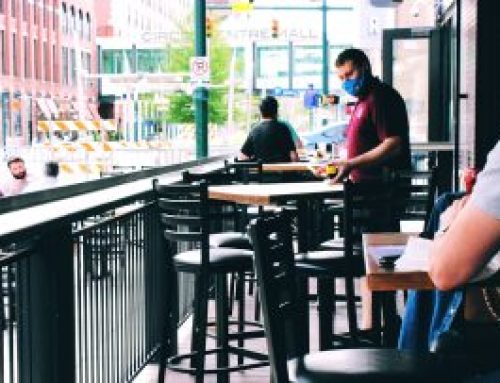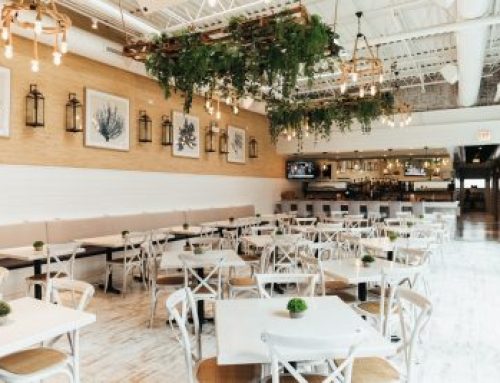(Current as of June 1, 2020)
As many states, counties, and cities are permitting the re-opening of businesses across the country, one of the primary concerns for business owners is how to take the appropriate steps to create a safe environment for customers and employees, as well as comply with applicable state and local rules. The following considerations are specific to California, with a focus on Los Angeles; however, they can be used as a checklist of safety measures to employ for nearly every business in the country. In addition, items specific to the restaurant industry are highlighted below in red. There are 5 primary categories to address, which are (i) physical distancing, (ii) cleaning and sanitization, (iii) employee health, hygiene, and training, (iv) facility safety, and (v) managing customer’s and their expectations.
I. Physical Distancing
- Take measures to ensure physical distancing is adhered to where customers and/or employees are waiting or otherwise in line, including payment registers and terminals, service counters, restrooms, elevator lobbies, host stands and waiting areas, valet drop off and pickup, and any other areas where customers may congregate.
- Place tape or other markings at 6-foot intervals in any area where members of the public may form a line or stand.
- Establish directional hallways and passageways for foot traffic, if possible, to eliminate employees and/or customers from passing by one another to closely.
- Design interaction between customers, delivery drivers, and employees to allow for appropriate physical distancing.
- Use contactless processes for pickup and delivery as well as other electronic systems for guest interactions, where possible.
- Limit interactions between employees and customers to a maximum of five minutes per occurrence, where possible.
- Discourage employees and customers from congregating in high traffic areas such as bathrooms, hallways, payment terminals/registers, etc.
- Require employees to avoid handshakes and similar greetings that break physical distance.
- Use barriers or increase distance between tables/chairs to separate employees in employee breakrooms. Where possible, create outdoor break areas with shade coverings and seating that ensures physical distancing.
- Stagger positions of stationary workspaces so employees can avoid sitting directly next to or opposite one another.
- Consider closing shared spaces in which physical distancing would be difficult to enforce or maintain, such as in small break rooms.
- Develop a plan to reduce congestion around time clocks and other congregation points.
- Provide and use face masks or face shields per local and state guidance.
- Require employees to wear face coverings per local and state guidance if they have direct contact with customers.
- Stagger employee schedules/shifts to limit crowding during the beginning and end of shifts, as well as during meal and rest breaks.
- Establish an exit from the facility separate from the entrance to allow for one-way foot traffic, if possible.
- Avoid in-person meetings as much as possible.
- If possible, an employee wearing a face covering is stationed near the entrance (but at least 6 feet from the nearest customers), to monitor that physical distancing procedures are being adhered to.
- Limit occupancy within the restaurant to ensure there is adequate distancing and/or physical barriers between dining tables that minimizes contact between customers at different tables.
- Prioritize outdoor seating and curbside pickup, as allowed by local zoning and planning codes.
- Expand outdoor seating where possible, in compliance with local zoning codes. For outdoor seating, maintain 6 feet physical distancing standards.
- Utilize technological solutions, where possible, to reduce person-to-person interactions, including mobile ordering, menu tablets, text on arrival for seating, and contactless payment options.
- Limit the number of guests at a single table. People in the same party seated at the same table do not have to be six feet apart. All members of the party must be present before seating and hosts must bring the entire party to the table at one time. On-site seating at a single table should be limited to no more than 6 people who should be members of one household.
- Indoor in-person dining capacity is not to exceed 60% of maximum occupancy to allow sufficient space between groups of customers; distancing should be 6 feet between groups of customers and/or use physical barriers. Outdoor seating is subject to adhering to the 6 feet physical distancing requirements between groups of customers, but it is not included in the 60% occupancy limit. Occupancy limits will be periodically re-evaluated to address potential occupancy increases.
- Bar/counter areas within the restaurant are closed to customers.
- Entertainment operations are prohibited, such as live bands.
- On-site dining is made by reservation or customers are notified to call in advance to confirm seating/serving capacity, where possible. Contact information for each party is collected either at time of reservation booking or on-site to allow for contact tracing, should this be required.
- Consider a phone reservation system that allows customers to wait outside or in their cars and enter only when a phone call, text, or other method notifies the customer that a table is ready.
- If the establishment has capacity and chooses to offer on-site ordering, customers should be offered a menu (posted or a single-use handout), to allow for ease of ordering, and items orders should be gathered, packaged and picked up by the customer within 15 minutes of the on-site order. Customers waiting for items may not congregate within the business; they should either remain in their car or return in 15 minutes to obtain their order.
- Install physical barriers such as partitions or Plexiglass at registers, host stands, ordering counters, etc., where maintaining physical distance of six feet is difficult or impossible.
- Limit the number of employees serving individual parties to the minimum number possible.
- Mark the floors of the kitchen and other back-of-house areas to reinforce physical distancing requirements.
- Physical distancing protocols should be used in any office areas, kitchens, pantries, walk-in freezers, or other high-traffic employee areas.
- If offering takeout and/or delivery, use “no touch” or contactless methods where possible.
II. Cleaning and Sanitization
- Use EPA-registered sanitation and disinfectant products.
- Complete thorough and detailed cleaning of entire premises prior to resuming operations, with focus on high-touch areas.
- Make hand sanitizer readily available, including at all entrances and throughout facility.
- All employees should clean hands often, including immediately after removing gloves and after contact with a person, by washing hands with soap and water for 20 seconds.
- Ensure sanitary facilities are operational and stocked with soap, hand sanitizer, and paper towels at all times.
- Cleaning staff should wear appropriate PPE for all cleaning tasks, and consider reducing business hours for extra deep cleanings.
- Launder all towels, tablecloths, uniforms, etc. frequently, using the warmest appropriate water setting, and wash all cloth face coverings after each shift.
- Provide enough time for workers to clean before, during and after shifts; generally, workers must be compensated for time spent on additional cleaning tasks they are assigned.
- If an individual tests positive for COVID-19, close off areas used by sick person until any areas affected can be cleaned and disinfected per CDC guidelines.
- Complete frequent sanitization of high-touch surfaces and shared items, per CDC guidelines (e.g., kitchens, door handles, tables, chairs, restrooms, points of sale).
- Disinfect all reused or shareable material between each use (e.g., shared food or drink preparation tools or items, table condiments, digital ordering devices, laminated menus, receipt trays, pens).
- If offering food delivery, ensure all transport containers are cleaned and sanitized.
- Avoid all food contact surfaces when using disinfectants.
- Discard paper menus after each customer use; if possible, post menus on wall(s).
III. Employee Health, Hygiene, and Training
- For employees who can carry out their work duties from home, direct them to do so. Vulnerable staff (those above age 65, those who are pregnant, and those with chronic health conditions) are assigned work that can be done from home whenever possible, and they should discuss any concerns with their healthcare provider or occupational health services to make appropriate decisions on returning to the workplace.
- Instruct employees not to come to work if they are sick or have been exposed to a person who has COVID-19.
- Provide all employees with information on employer and government-sponsored leave benefits that the employee may be entitled to receive, which would make it financially easier to stay at home, including employee sick leave rights under the Families First Coronavirus Response Act.
- Upon being informed that one or more employees tests positive for, or has symptoms consistent with COVID-19, have protocol in place to have such employees isolate themselves at home and require the immediate self-quarantine of all employees that had a workplace exposure to such employees. The protocol should consider providing all quarantined employees with access to COVID-19 testing to determine whether there have been additional workplace exposures which may require additional control measures.
- Require employees who have COVID-19 CDC-defined symptoms to remain home until they are symptom-free for three days without medication.
- If an employee tests positive for COVID-19, inform co-workers and customers, if applicable (while maintaining confidentiality to the extent possible), and ensure all other co-workers are tested before returning to work; if testing is not possible, inform co-workers who had close contact to self-quarantine and self-monitor for symptoms per public health guidance.
- If any business owner, manager, or operator knows of 3 or more cases of COVID-19 within the workplace within a span of 14 days, the business must report such information to the California Department of Public Health.
- Conduct symptom checks before employees may enter the workplace, including questions concerning cough, shortness of breath, or fever and any other symptoms the employee may be experiencing. These checks can be done remotely or in person upon the employees’ arrival. A temperature check should be done at the workplace if feasible.
- Previously sick employees who are returning to work should follow the CDC’s guidance for discontinuation of home isolation.
- All employees who have contact with the public or other employees during their shift(s) are offered, at no cost, a cloth face covering. The covering is to be worn by the employee at all times during the workday when in contact, or likely to come into contact, with others. Employees need not wear a cloth face covering when the employees are alone.
- Instruct all employees on the proper use of face coverings, including the need to wash their face coverings daily. Face shields are to be cleaned and disinfected per manufacturer’s directions.
- Instruct all employees to regularly wash their hands for at least 20 seconds with soap and water, especially after going to the bathroom, before eating, after blowing their nose, coughing or sneezing, and after extended contact with high-touch surfaces. If soap and water are not readily available, they can use an alcohol-based hand sanitizer with at least 60% alcohol.
- Remind employees to cover coughs and sneezes with a tissue. Used tissues should be thrown in the trash and hands washed immediately with soap and water.
- Prohibit employees from eating or drinking anywhere inside the premises other than designated break rooms.
- Provide clear instructions to all employees, vendors, and delivery personnel regarding maintaining physical distance and the use of face coverings when around others.
- Stagger all breaks to ensure that 6 feet between employees can be maintained in break rooms, and in compliance with applicable wage and hour regulations.
- Disinfect all break rooms, restrooms, and other common areas frequently and in accordance with a routine schedule.
- Consider making special modifications for vulnerable employee and customer populations, such as special hours of operation for customers over 65 years old and low-contact roles for vulnerable employees.
- If using gloves, instruct employees to wash their hands before putting on, and after taking off, the gloves, and to follow CDC guidelines on how to take off gloves.
- Train all employees on the importance of frequent handwashing and the use of hand sanitizers with at least 60% alcohol content and give employees clear instruction to avoid touching hands to face.
- Train all employees on symptom detection, sources of high risk to COVID-19, COVID-19 exposure prevention measures, and employee leave benefits/policies.
- Establish a safety team or designate certain employees to monitor workplace safety, conduct safety trainings, and carry out health screenings.
- Conduct demonstrations and training sessions to introduce new skills to staff before activities officially resume, including (i) how to practice physical distancing, (ii) how to properly sanitize surfaces and wash hands, (iii) how to properly wear and clean face coverings, (iv) how to follow the floor markings in the premises, and (v) how to handle interactions with other employees and customers.
- Document all COVID-19 related trainings, training completions, and communications to employees regarding operational changes or positive cases in the workplace.
- Identify employee stressors and mitigate employee anxiety about going back to work through clear and transparent communication, listening, and surveying employees regularly. Provide training and updates to employees on new and pre-existing wellness programs offered by or through the business.
- Instruct employees to not use other employees’ workstations or other work tools and equipment, where possible. If necessary, clean and disinfect them before and after use. Instruct employees to regularly clean and disinfect frequently touched objects around them.
- Utilize a variety of communication channels and materials, including email, text messages, posters/digital displays to inform employees of what to expect when returning to work, including new entrance guidelines, sanitization requirements, physical distancing, capacity limits, face covering requirements, etc.
- Face shields should be provided to, and worn by, employees when servicing customers who have removed their face coverings to eat and drink. Such face shield is to be worn in addition to the cloth face covering.
IV. Facility Safety
- The HVAC system is in good, working order and, to the maximum extent possible, ventilation has been increased. Consider installing portable high-efficiency air cleaners, upgrading the building’s air filters to the highest efficiency possible, and making other modifications to increase the quantity of outside air and ventilation in all areas of the premises.
- For facilities that have not been operating, flush each of the hot and cold-water fixtures for five minutes prior to reopening to replace stale water in the facility’s plumbing with a fresh and safe water supply.
- Thoroughly clean and sanitize/disinfect the premises prior to re-opening, using products approved for such use against COVID-19. Thereafter, thoroughly clean and sanitize/disinfect the premises at least nightly.
- Ensure that deliveries made to the business are conducted away from high traffic areas and the public. Eliminate person-to-person contact for deliveries, whenever possible.
- Develop and routinely follow a cleaning and disinfection plan for high-touch surfaces and access areas. Consider engaging a third-party cleaning company to assist with the increased cleaning demand, as needed, and keep a log to monitor completion.
- Disinfect common areas and frequently touched objects related to customer pickup and payment (e.g., tables, doorknobs or handles, credit card readers) on an hourly basis during business hours using EPA approved disinfectants. Disinfect all payment portals, pens, and styluses after each use.
- Clean and disinfect all restrooms on an hourly basis using approved EPA disinfectants.
- Ensure that hand sanitizer, tissues, and trash cans are available to the public at or near the entrance of the facility. Consider installing touchless options for hand sanitizer, soap, paper towels, and trash disposal.
- Customers should enter through doors that are propped open (which may be evaluated for approval based on overall vermin exposure) or automated, if possible.
- Customers who refuse to wear a cloth face covering may be refused service and asked to leave.
- Customers arriving at the site with children must ensure that their children stay next to a parent, avoid touching any other person or any item that does not belong to them, and are wearing face coverings if age permits.
- Encourage cashless transactions. If reasonable, ask customers to swipe their own credit/debit cards, and fully sanitize card readers between each guest use. Provide and encourage the use of contactless payment options where possible, such as through a phone app or online order.
- Log all persons who come on-site for purposes of supporting public health contact tracing.
- Explore outdoor options for breaks and lunch times, if available and safe.
- Ensure adequate storage of necessary materials to meet PPE and cleaning requirements.
- Post signage to communicate applicable health and safety guidelines to all employees, including a contact person to report violations.
- Fully equip spaces such as dining rooms, host stands, and kitchens with proper sanitation products, including hand sanitizer and sanitizing wipes for all employees directly assisting customers.
- Follow all food safety practices outlined in the California Retail Food Code. Keep hot food hot (135 °F or above) and cold food cold (41 °F or below). Thoroughly cook foods as required under the Code.
- Clean and sanitize utensils and equipment at the required frequency outlined in the California Retail Food Code.
- Adhere to applicable employee health and hygiene practices under local law: Don’t work when ill; wash hands frequently; use gloves as required by the California Retail Food Code.
- Ensure that all food and food ingredients are from an approved food source.
- Discourage food preparation employees from changing workstations, or entering others’ workstations, during shifts.
- Ensure that food from self-service machines, such as soda and frozen yogurt machines, is dispensed by a designated food handling employee and that all such machines and areas are cleaned/sanitized frequently.
- Close all areas where customers may congregate or touch food or foodware items that other customers may use or touch. Instead, provide these items directly to the customers on an individual basis and discard (or clean/disinfect) after each use, as appropriate. This includes, but is not limited to, (i) self-service areas with condiment caddies, utensil caddies, napkins, lids, straws, to-go containers, etc., (ii) self-service food areas, such as salsa bars, salad bars or buffet-style areas, including food sampling, (iii) tableside food preparation and presentation such as food item selection carts and conveyor belts, guacamole preparation, etc., and (iv) after-meal mints, candies, snacks, or toothpicks (which can be offered with the check and provided only on request).
- Designate a food employee with the task of wrapping silverware prior to providing it to customers, rather than multiple employees handling uncovered silverware prior to customer use.
- Refrain from refilling beverages at the table or from common containers (e.g. pitchers, carafes, decanters, bottles). Instead, clean glassware should be provided for customer refills.
- Designate a food employee, per shift, to oversee and enforce the restaurant’s sanitization and disinfection procedures, as needed.
- Provide dishwashers with equipment to protect their eyes, nose, and mouth from contamination due to splash using a combination of face coverings, protective glasses, and/or face shields. Also provide all dishwashers with impermeable aprons that must be changed frequently. Reusable protective equipment such as face shields and glasses are to be properly disinfected between uses.
- Instruct customers that they must wear cloth face coverings to be served. This applies to all adults and to children over the age of 2. Only individuals with chronic respiratory conditions or other medical conditions that make the use of a face covering hazardous are exempted from this requirement. Customers may remove cloth face coverings while eating and drinking.
- Ensure that servers, bussers, and other employees moving items used by customers (dirty cups, plates, napkins, etc.) or handling trash bags use disposable gloves (washing their hands before putting the gloves on and after removing them) and are provided aprons which they must change frequently.
- Clean and disinfect all reusable menus between customer use. If using paper menus, discard after each customer use. Alternatives such as stationary menu boards, electronic menus, or mobile device downloadable menus should be considered.
- Clean and sanitize all customer seating areas after each use. Any items on each table must be single-use or cleaned/sanitized between customers. Each table should have either a top cloth (which is replaced between guests) or a hard non-porous surface (which is fully sanitized between guests).
- Ensure that no flatware, glassware, dishware, menus, condiments or any other tabletop item is present on tables prior to the seating of customers. All such items should be fully sanitized between seat changes and stored during non-use in a location that prohibits potential contamination.
- Ensure that takeout containers are filled by customers and are available only upon request.
- Limit the use of re-usable items such as bags, silverware, pens, non-disposable condiments, and menus.
- Keep play areas closed and modify or discontinue the use of shared entertainment items such as pool tables, arcade games, board games, and vending machines.
V. Managing Customers and Their Expectations
- Post signage at entrance notifying customers that they will be screened for symptoms upon arrival, asked to use hand sanitizer, and to wear a face covering (when not eating or drinking).
- Post signage about maintaining physical distancing of six feet, washing hands or using sanitizer upon entry into the business, and to stay home if the customer is ill or has symptoms consistent with COVID-19.
- Business’s website and social media provide clear information about facility hours, required use of face coverings, policies with regard to pre-ordering, reservations, pre-payment, pickup and/or delivery and other relevant issues.
- Post signage throughout the premises regarding health and safety guidelines, including proper hygiene and sanitization, physical distancing, and PPE guidance (including proper use of face coverings).
- Encourage spacing between customers waiting in line by placing floor markings (e.g., tape) 6 feet apart.
- Install floor markings (e.g., tape or graphics) to instruct people where to walk.
- Place partitions or plexiglass shields at checkout counters between customers and employees.
- Have one dedicated entrance to control customer flow into the business and have staff assigned to monitor capacity (at minimum 6-foot distance).
- Per Los Angeles and California state guidance, guests should bring and wear a face covering when not eating or drinking.
- Discontinue use of salad bars, buffets or beverage stations that require customers to use common utensils/dispensers.
- If taking orders at tables, instruct servers to stand several feet away from table while speaking to customers.
- Place tables 6 feet apart or consider only using every second table for customers.
- Signage is posted that notifies customers that while it may be common practice for diners to socialize after eating, this practice will be discouraged during the pandemic.
- Install floor markings showing where to place tables and chairs to promote physical distancing.








